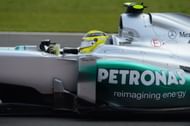Mercedes AMG Petronas team started the 2012 F1 season on a high with some strong qualifying performances and a win in China but their form dwindled as the season progressed. In the first half of the season, Mercedes’ average qualifying position was 3.8 while in the second half, that rose to 9.2. So, what caused this decline in performance? Was it the slow development rate or was it the double DRS? Let’s take a closer look.
Double DRS Saga:
In late 2011, Mercedes started to test the passively operated DDRS system. The gains observed during the Friday practice sessions meant that the team committed to the system early on and decided to design their 2012 challenger around it.
Initially, when the 2012 season got under way, DDRS was hailed as a great innovation and teams like Lotus appealed to FIA to ban such systems as they felt it gave Mercedes an illegal advantage. After Nico Rosberg’s win in China, many in the F1 paddock did believe that the DDRS was a must-have device and many of the teams started their own development programmes to get it on their car as soon as possible.
So, what went wrong with DDRS ?
The main issue was of flow reattachment. The Double DRS system on the Mercedes worked by feeding the air from a small inlet to a slit present in the underside of the front wing. This stalled the front wing which disrupted the airflow to the rear diffuser and the rear wing. This disruption in airflow stalled the rear wing and the rear diffuser.
Note: All the above mentioned phenomena took place when the DRS wing was opened.
The result of this was an increase in top speed on the straights but when the DRS was closed, it took the front wing a few milliseconds to switch back on again, i.e to function normally. This delay of a few milliseconds caused corner entry understeer. So both Michael and Nico had to enter the corner at a much more slower speed.
Mercedes engineers tried to solve this problem by making certain tweaks with the car setup, which meant that the team had to compromise on other areas and their car setup was dictated by their DDRS system. The ultimate result was that the Engineers couldn’t find an optimum setup which would suit both DDRS and the track characteristics.
Now, a question would arise as to why this problem didn’t affect Mercedes in the early part of the season?
Earlier in the season, the track characteristics suited the Mercedes car and the understeer problem didn’t affect them too much.
But on circuits like Silverstone and Hungaroring, which have a lot of fast high speed corners, both Mercedes drivers had problems with mid-corner and corner entry understeer, which meant that they had to take the corners at a slower speed than other top teams.
The focus on the DDRS system also meant that the team was very late with the introduction of their Coanda exhaust. And, if the trends are closely analysed, Coanda exhaust system was the best solution to the rule changes for the 2012 F1 season, as all the top 3 teams ran Coanda exhausts from early part of the season.
Slow Development Rate:
Slower development rate, as compared to their rivals, was another major reason as to why Mercedes failed to perform in the 2012 season. While most of the top teams had introduced major upgrade packages by the Hungarian GP, Mercedes left the major upgrades until Singapore. This meant that their engineers had very less time to understand the Coanda exhaust system with a number of back to back races in the second half of the season.
Apart from that, top teams like Mclaren, Red-Bull and Ferrari brought minor upgrades to their car at almost all the races while the Mercedes team didn’t bring any such minor upgrades until the second half of the season. The main reason for that was again the problems with DDRS system and excessive tyre wear. These two problems took away the focus that was required to develop other aerodynamic components and the end result was a very poor performance in the second half of the season, with just 18 points from last seven races.
Mercedes Qualifying Data:
The above picture depicts the qualifying performances of 2012 Mercedes AMG drivers, Michael Schumacher and Nico Rosberg. From the above data, it’s quite clear as to how the performances of both the drivers have dwindled as the season has progressed. In the first few races, both of the drivers were regularly inside top 8 places. But after the British Grand Prix, neither of them have showed consistent performance and failed to make into Q3(final leg of qualifying) numerous times. The reason for that was slow development rate caused due to extra focus on DDRS and failure in optimising the Coanda exhaust system.
Note: Michael Schumacher’s poor performance in BAH (Bahrain Grand Prix) was due to a DRS failure in qualifying. His performances in British and German Grand Prix were exceptionally good due to the wet weather conditions.


